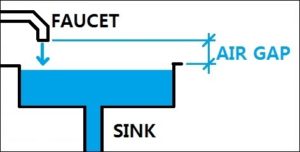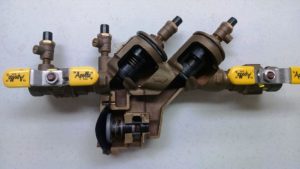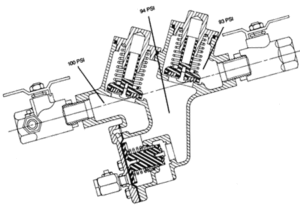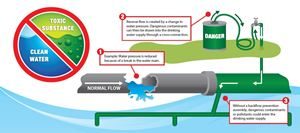What is a backflow prevention device?
Backflow prevention device is a plumbing device that is installed on water pipe line to prevent contaminated water or chemicals from flowing back into the public water supply system. Certain types of businesses are legally mandated to install and operate approved backflow preventers.
Most of them are businesses that utilize chemicals, drugs, foods, or any kind of elements that might be hazardous to health or lower the quality of drinking water.

What Is RPZ?
RPZ (Reduced Pressure Zone) is a type of backflow prevention device that is widely used to contain premises utilizing hazardous materials from entering city water supply.
Its internal structure is consisted of three main factors. Two check valves in line forming a chamber and one relief valve at the chamber. During normal condition, first check valve opens and greatly reduces water pressure that flows into the chamber.
If this reduced pressure has difference of 5 psi or greater than original pressure, relief valve stays in closed position. Thus water flows through the device.
But when backflow condition occurs, inverse water flow makes second check valve closed. If the check valve could not stop the flow, then the chamber will build up pressure and differential pressure will fall below 5 psi.
Before the falling differential pressure reaches 2 psi, the relief valve opens and releases water filled in the chamber. It will temporarily empties the chamber to break the connection.

Why are backflow prevention devices required?
Backflow prevention devices are an important component of the New York City Department of Environmental Protection’s drinking water protection program and are legally mandated under the New York State Sanitary Code and the Rules of the City of New York for those businesses identified as posing a risk to the public water supply.

History of Backflow Preventer
Public health officials have long been concerned about cross-connections and backflow prevention as early as the turn of the century. However, it wasn’t until 1974, when Congress established the Safe Drinking Water Act (SDWA), that unprotected cross-connections were required to be eliminated or protected in order to safeguard human health from contaminants in drinking water.
Part of the Act included the installation and maintenance of backflow prevention devices. These devices are installed wherever a cross-connection occurs.
Without a backflow prevention device at cross-connections, drinking water can become contaminated by a backflow condition.

Who is responsible for installing a backflow prevention device?
Property owners are required to install, maintain and test backflow prevention device according to all relevant City and State codes. Legally tenants are not responsible for backflow prevention devices. However, some tenants may be responsible due to their property lease contracts.





